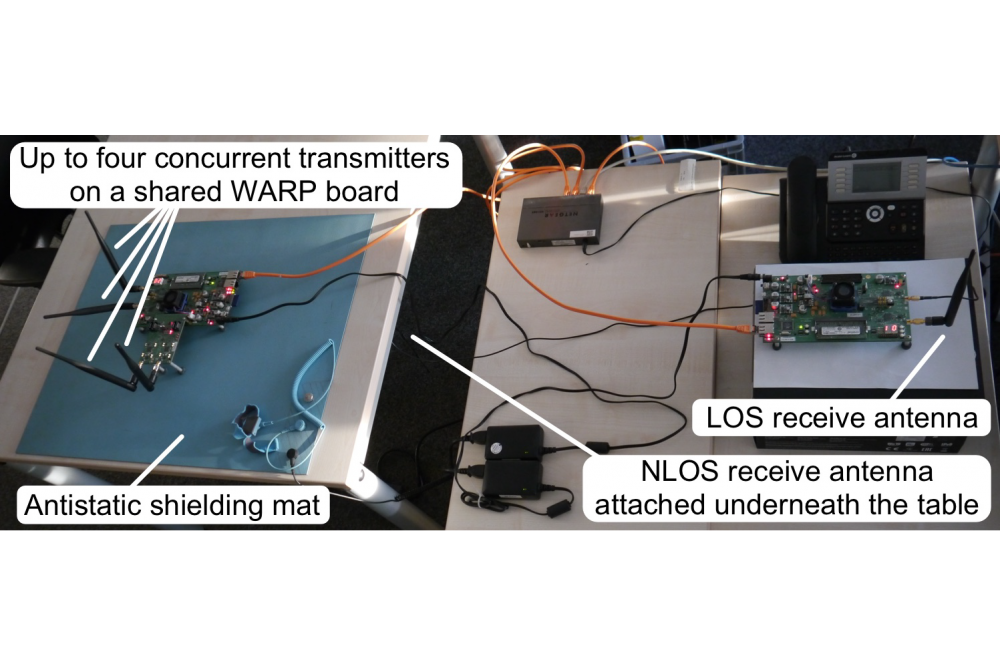Decoding Concurrent IEEE 802.11 Transmissions with Imprecise Synchronization
Introduction
Future wireless communication systems are envisioned to meet stringent latency requirements to support control applications and machine interactions. One important step in this direction is to eliminate waiting times in the protocol stack, which can be achieved by letting multiple nodes transmit the same data concurrently just when the data becomes available. However, imperfect transmitter synchronization may arise in such low-latency schemes, which causes signal incoherence, which in turn prohibits reception with conventional decoding techniques. Hence, we have devised a novel equalization technique called time-variant zero-forcing (TVZF) that relaxes the requirements for time and frequency synchronization in concurrent multi-user transmissions by dealing with non-stationary interferences. We have implemented a TVZF-based receiver for IEEE 802.11g (Wi-Fi), which we tested and evaluated on the Lichtenberg HPC with various datasets.
Methods
We conducted several testbed experiments with software-defined radios, in which we systematically tuned various system parameters in combination to assess our receiver’s performance. In particular, the most relevant parameters are the time and frequency offsets between concurrent transmitters. In addition, we also varied the number of concurrent transmitters, line-of-sight (LOS) vs. non-line-of-sight (NLOS) communication, the modulation rate, the frame length, and the transmitter gains. We recorded and stored the received IQ samples from the software-defined radios for offline evaluation, which allows us to compare the effects of different decoder settings when processing the same datasets. For instance, a dataset with a combined parameter sweep of 81 different time offsets and 101 different frequency offsets and 100 repetitions comprises 818 100 frames sampled at 40 MHz, which occupies some 740 GiB of disk space after compression.
Results
We conducted a first phase of experimental evaluations in July 2018 with datasets that comprise combined parameter sweeps of timing offsets from -1 μs to +1 μs in 81 steps and frequency offsets from -5 kHz to +5 kHz in 101 steps, with 2, 3, and 4 concurrent transmitters, in line-of-sight and non-line-of-sight, respectively. The decoder was additionally set up in different configurations to investigate tradeoffs between speed and accuracy. The results obtained from these experiments demonstrated the effectiveness of our TVZF-based receiver and gave us valuable insights into the decoding process to improve our design.
In the second phase of computations conducted in March and April 2019, we analyzed our receiver’s decoding performance also for higher frequency offsets up to 20 MHz. With higher frequency offsets between concurrent transmitters, the SNR at the receiver is inevitably reduced due to stronger inter-carrier interference, but we found our receiver to be still very effective under such conditions. In addition, we evaluated TVZF decoding also for variable frame lengths. The results show that TVZF can equalize concurrent transmissions better for longer frames in static environments, as it can collect more information about the interference patterns. Finally, we evaluated the decoding of asynchronous concurrent transmissions under conditions of different transmitter gains. While conventional decoding fails to decode frames when the mutual interference exceeds a certain level, our TVZF-based receiver successfully decodes Wi-Fi frames also under conditions of strong mutual interference.
Discussion
The results obtained from computations on the Lichtenberg high performance computer were aggregated to create plots with various performance metrics as a function of the combined effects of the swept parameters. These performance metrics include the frame reception rate (FRR), the bit error rate (BER), and the error vector magnitude (EVM). This allowed us to compare the effects of different experiment setups and processing settings, to identify challenging conditions for our decoder, and to investigate the decoding process in detail to improve our design. The results show that TVZF-based decoding is capable to decode asynchronous concurrent transmissions under a wide range of conditions, under most of which conventional decoders fail.




